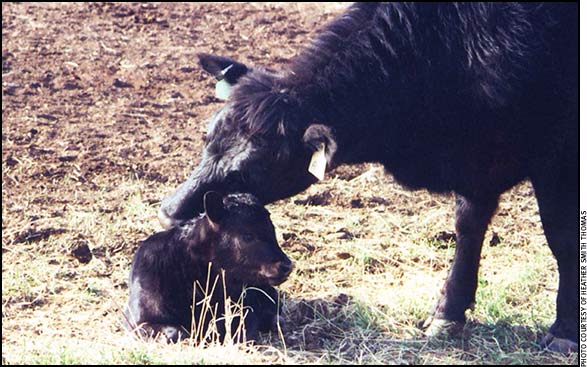
Birth Weight and Gestation Length
Many factors affect birth weight and gestation, and many of those are heritable.
Several factors affect birth weight in calves, including breed, genetics of sire and dam, length of gestation, age and size of dam (heifers tend to have smaller calves than mature cows, and large cows tend to have larger calves than small cows), sex of the calf, environmental factors, and nutrition and health of the dam. Bull calves in the same breed tend to be larger than heifer calves, partly because males are larger than females and male calves tend to be carried a day or more longer than heifer calves.
Gestation length is heritable, however. Some family lines within breeds tend to have gestation lengths that differ from the “average” 283 days. Low-birth-weight cattle often have shorter gestation length, and high-birth-weight cattle tend to have longer-than-average gestation length. The fetus is growing fastest in the final stage of gestation; several more days of gestation creates a larger calf. One study showed that each extra day of gestation amounts to at least a 1-pound (lb.) increase in calf size.
Michael MacNeil, retired from the research station at Miles City, Mont., and now with a consulting business, participated in research projects looking at gestation length, calving ease, etc.
“Intermediate optimum is important, rather than either extreme,” he says. “If gestation length is too short, calves are born too small, premature and die. If calves are carried too long, they get too big, and this is also a problem. There’s a fairly narrow window of acceptable gestation length.” Outliers present severe challenges.
There are advantages, like easier births, to having calves on the lower end of average rather than on the high end of average where you end up pulling 120-lb. calves or delivering them by C-section.
“Heritability for gestation length is moderate. Estimates of heritability are around 0.3, which means it’s just a bit higher in heritability than weaning weight. The misleading thing is that we can select for weaning weight and actually change it, whereas there’s a limit to how much we can select for gestation length and change it. We can select for bigger and bigger weaning weight almost indefinitely — and this is what many breeds have done in the past 50 years. On the other hand, if we select for shorter gestation, we can only make them shorter by a little and still have a healthy, viable calf,” he explains.
“To minimize calving difficulty, you should select on direct and maternal calving ease EPDs (expected progeny differences). In reality you might not care whether the gestation length is 279 days or 286 days (a practical range), as long as the calf is born easily. There’s only about a 10-day window that’s actually useful — though a calf carried 278 days may be born easier than one carried 288 days.”
The dam doesn’t have as much influence on gestation length as does the sire — though she has an influence on how big the calf gets before it’s born. A large cow tends to have a larger calf, and nutrition provided by the dam to the fetus can make a difference in how fast it grows. However, actual gestation length is determined mainly by the calf itself (his fetal maturity triggers labor) and this is a function of his genetics via his sire. Some bulls consistently sire longer- or shorter-gestation calves than average.
“The most important trait for selection attention is calving ease. Gestation length may change if you select for calving ease as a correlated response, but you make the most progress by selecting for it indirectly,” he explains.
“If you try to select for certain targets in calving ease — birth weight, gestation length, pelvic area, etc. — simultaneously to improve calving ease, very few breeders will get the correct emphasis on each of these various EPDs to actually make the progress they want. It’s a challenge to make those decisions in the correct relative importance. Those multiple traits can help us attempt to manipulate calving ease, but most of the calving ease evaluations consider the birth weight information simultaneously with any other parameters. So if you are selecting for calving ease, you wouldn’t need to put any more emphasis on birth weight than what is already in the EPD evaluation for calving ease; it’s already factored in and the math has already been done,” he says.

Editor’s Note: Heather Smith Thomas is a freelance writer and cattlewoman from Salmon, Idaho.






